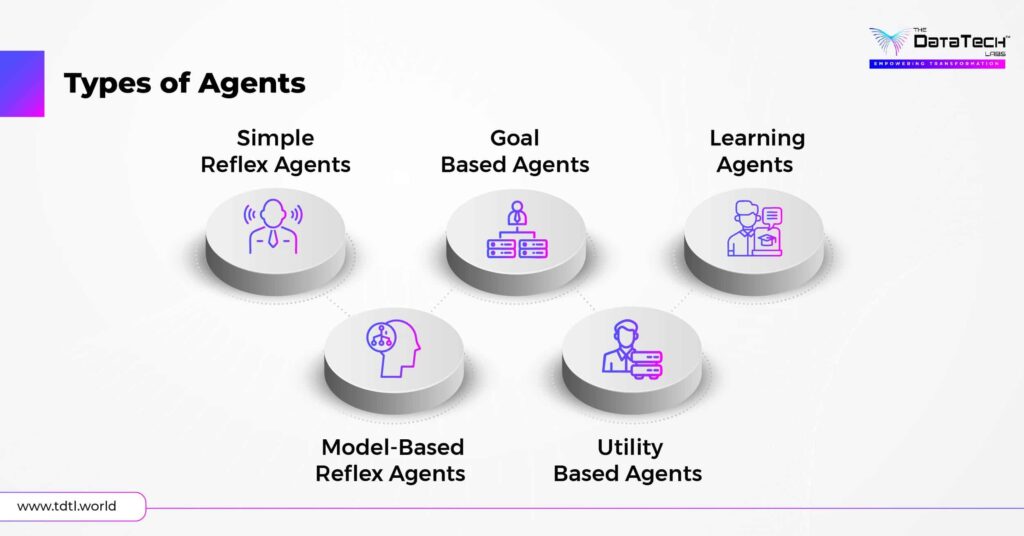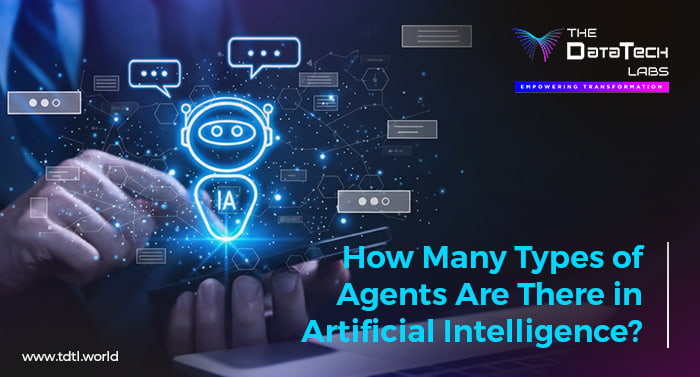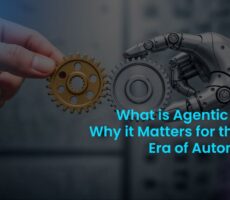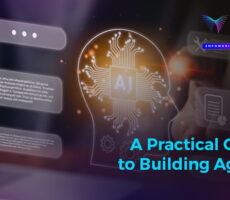There are a few core types of artificial intelligence agents, each with their own capabilities and relevance for businesses. These agents are the “doers” in AI, meaning they are autonomous agents that interact with their environment, make decisions, and complete tasks with minimal (or no) human cognition or involvement . Below, we’ll discuss the different types of agents and what makes them unique, as well as how organizations can put them to work.
What Is an AI Agent?
An AI agent is an autonomous entity that can sense the environment with sensory mechanisms, think based on the perceptions it collects, and act with actuators to pursue an objective.
AI agents are not static programs, they are dynamic and can be affected by feedback; they learn from outcomes and adjust their behavior to improve performance over time. Because of this, AI agents are the underpinnings of agentic AI, where systems can take action on their own, as opposed to waiting for a command from humans.
So, How Many Types of Agents Are There in Artificial Intelligence?
Traditionally, artificial intelligence literature (particularly in Russell and Norvig’s foundational text Artificial Intelligence: A Modern Approach) classifies agents into five main types. These range from the simplest reflex-based systems to highly adaptive, learning-driven models.

Simple Reflex Agents
- How they work: Respond instantly to specific inputs with preset rules (if X, do Y).
- Best for: Predictable environments.
- Business use: Basic automation, like motion-triggered lights or rule-based customer alerts.
Model-Based Reflex Agents
- How they work: Keep an internal “memory” to track things not visible right now.
- Best for: Environments where some context or history matters.
- Business use: Robots that monitor inventory and change course based on what’s been tracked.
Goal-Based Agents
- How they work: Plan ahead to pick actions that move them closer to defined goals.
- Best for: Tasks that need flexible thinking (not just fixed responses).
- Business use: AI tools that prioritize tickets to improve customer happiness or minimize wait times.
Utility-Based Agents
- How they work: Weigh different options and choose the one with the best expected outcome, according to some measurable success metric (utility).
- Best for: Optimization where trade-offs are common (speed vs. cost, risk vs. reward).
- Business use: Trading bots that balance potential profit against risk in real-time.
Learning Agents
- How they work: Upgrade themselves by learning from past experiences, getting better at tasks over time.
- Best for: Dynamic, changing environments.
- Business use: Recommender systems, AI for supply chain logistics, or marketing campaigns that get smarter based on what works.
At a Glance: Comparing Agent Types
| Agent Type | Key Trait | Awareness Level | Autonomy | Example |
| Simple Reflex | Rule-based reactions | None | Low | Thermostats, alarms |
| Model-Based | Tracks internal state | Partial | Medium | Warehouse robots |
| Goal-Based | Planning for objectives | Goal-aware | High | Automated process advisors |
| Utility-Based | Optimizes for outcomes | Quantitative | High | AI trading or risk systems |
| Learning | Self-improving | Expanding | Very High | Personalized recommendations |
The Next Wave: Agentic AI Ecosystems
Cutting-edge AI doesn’t stop at these five. Today, multi-agent systems (MAS) are on the rise, networks of agents cooperating to solve complex problems, each specializing in certain tasks. Organizations also use:
- Hierarchical agents: Main agents delegating jobs to smaller agents.
- Cognitive/hybrid agents: Combining logic and data-driven learning for deeper insights.
These build the backbone for tools like autonomous research tools, workflow AI, and self-managing digital platforms.
Why Does This Matter for Enterprise Leaders?
Recognizing agent types isn’t just tech jargon; it’s a strategic lens for leaders:
- Simple and model-based agents automate repetitive, rule-bound workloads.
- Goal-based agents support dynamic optimization, ideal for operations with shifting priorities.
- Learning agents offer the deepest adaptability, able to evolve as business needs change.
The higher up you go, the greater the potential for competitive advantage, but also the need for oversight, governance, and trust.
Key Takeaways
- There are five fundamental AI agent types: simple reflex, model-based reflex, goal-based, utility-based, and learning agents.
- Each step up means greater autonomy and capability.
- The most advanced, Agentic AI, merges these types into collaborative systems, delivering intelligent, self-driven operations for modern enterprises.
This knowledge empowers leaders to integrate the right kind of AI at every level, from automating simple tasks to building adaptive, resilient systems that grow with their business.
FAQ's
The five classics: simple reflex, model-based reflex, goal-based, utility-based, and learning agents.
Model-based and learning agents dominate in analytics, automation, and personalization.
Goal-based agents target specific objectives; utility-based agents optimize for the best overall outcome.
No. Learning agents improve how they decide or act over time; generative AI produces new content but can be part of a learning agent’s system.
They combine various agent types, working together for more robust results.
Agentic AI: smart, multi-agent collaboratives capable of autonomy, cooperation, and rapid adaptation.







How do Backlink works for SEO
I believe this is one of the such a lot significant information for me. And i am happy reading your article. But want to remark on some common things, The web site taste is great, the articles is in reality great : D. Just right job, cheers
Josephtut
Now all became clear, many thanks for the information. You have very much helped me.
——
https://hosting.estate/performance/